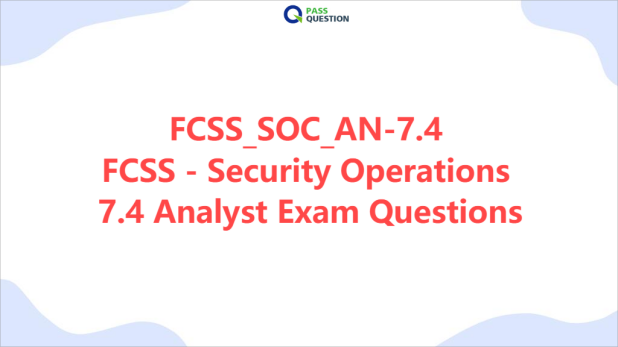FCSS_SOC_AN-7.4 FCSS - Security Operations 7.4 Analyst Exam Questions
The FCSS_SOC_AN-7.4 FCSS - Security Operations 7.4 Analyst Exam is an obligatory examination for those seeking the FCSS in Security Operations Certification. This exam is crucial in evaluating the competencies and understanding of the test-taker in the field of Security Operations. PassQuestion has just released the FCSS_SOC_AN-7.4 FCSS - Security Operations 7.4 Analyst Exam Questions. This comprehensive set of questions encompasses all the knowledge points that are integral to the real FCSS_SOC_AN-7.4 exam. By using these FCSS_SOC_AN-7.4 FCSS - Security Operations 7.4 Analyst Exam Questions, you will be well-prepared to tackle the real exam. This will undoubtedly help you pass your Fortinet FCSS_SOC_AN-7.4 exam with ease, bringing you one step closer to achieving your Security Operations Certification.

FCSS in Security Operations Certification Path
The FCSS in Security Operations certification validates your ability to design, administer, monitor, and troubleshoot Fortinet security operations solutions. This curriculum covers security operations infrastructures using advanced Fortinet solutions. We recommend this certification for cybersecurity professionals who require the expertise needed to design, manage, support, and analyze advanced Fortinet security operations solutions. To obtain the FCSS in Security Operations certification, you must pass one elective exam. The certification will be active for two years.
Elective Exams
FCSS - Advanced Analytics Architect
FCSS - Security Operations Analyst
FCSS - Security Operations 7.4 Analyst Exam
The FCSS - Security Operations 7.4 Analyst exam evaluates your knowledge and skills in designing, deploying, and managing a Fortinet SOC solution using advanced FortiAnalyzer features and functions to detect, investigate, and respond to cyberthreats. This exam tests your knowledge and skills related to configuring FortiAnalyzer SOC features and functions, various FortiAnalyzer deployment architectures, incident handling and analysis, and automation. The FCSS - Security Operations 7.4 Analyst exam is intended for security professionals involved in the architectural design, implementation, and monitoring of Fortinet SOC solutions based on FortiAnalyzer.
Exam Information
Exam name: FCSS - Security Operations 7.4 Analyst
Exam series: FCSS_SOC_AN-7.4
Time allowed: 65 minutes
Exam questions: 32 multiple-choice questions
Scoring Pass or fail. A score report is available from your Pearson VUE account.
Language: English
Product version: FortiAnalyzer 7.4, FortiOS 7.4
Fortinet FCSS_SOC_AN-7.4 Exam Objectives
Successful candidates have applied knowledge and skills in the following areas and tasks:
SOC concepts and adversary behavior
- Analyze security incidents and identify adversary behaviors
- Map adversary behaviors to MITRE ATT&CK tactics and techniques
- Identify components of the Fortinet SOC solution
Architecture and detection capabilities
- Configure and manage collectors and analyzers
- Design stable and efficient FortiAnalyzer deployments
- Design, configure, and manage FortiAnalyzer Fabric deployments
SOC operation
- Configure and manage event handlers
- Analyze and manage events and incidents
- Analyze threat hunting information feeds
- Manage outbreak alert handlers and reports
SOC automation
- Configure playbook triggers and tasks
- Configure and manage connectors
- Manage playbook templates
- Monitor playbooks
View Online FCSS - Security Operations 7.4 Analyst FCSS_SOC_AN-7.4 Free Questions
1.Which connector on FortiAnalyzer is responsible for looking up indicators to get threat intelligence?
A. The FortiGuard connector
B. The FortiOS connector
C. The FortiClient EMS connector
D. The local connector
Answer: A
2.In the context of SOC operations, mapping adversary behaviors to MITRE ATT&CK techniques primarily helps in:
A. Speeding up system recovery
B. Predicting future attacks
C. Understanding the attack lifecycle
D. Facilitating regulatory compliance
Answer: C
3.You are managing 10 FortiAnalyzer devices in a FortiAnalyzer Fabric. In this scenario, what is a benefit of configuring a Fabric group?
A. You can apply separate data storage policies per group.
B. You can aggregate and compress logging data for the devices in the group.
C. You can filter log search results based on the group.
D. You can configure separate logging rates per group.
Answer: C
4.In managing events and incidents, which factors should a SOC analyst focus on to improve response times? (Choose Three)
A. Speed of alert generation
B. Accuracy of event correlation
C. Time spent in meetings
D. Clarity of communication channels
E. Efficiency of data entry processes
Answer: ABD
5.When designing a FortiAnalyzer Fabric deployment, what is a critical consideration for ensuring high availability?
A. Configuring single sign-on
B. Designing redundant network paths
C. Regular firmware updates
D. Implementing a minimalistic user interface
Answer: B
6.What should be prioritized when analyzing threat hunting information feeds? (Choose Two)
A. Accuracy of the information
B. Frequency of advertisement insertion
C. Relevance to current security landscape
D. Entertainment value of the content
Answer: AC
7.Why is it crucial to configure playbook triggers based on accurate threat intelligence?
A. To ensure SOC parties are well-attended
B. To prevent the triggering of irrelevant or false positive actions
C. To increase the number of digital advertisements
D. To facilitate easier management of office supplies
Answer: B
8.Which two assets are available with the outbreak alert licensed feature on FortiAnalyzer? (Choose two.)
A. Custom event handlers from FortiGuard
B. Outbreak-specific custom playbooks
C. Custom connectors from FortiGuard
D. Custom outbreak reports
Answer: AD
9.Which trigger type requires manual input to run a playbook?
A. INCIDENT_TRIGGER
B. ON_DEMAND
C. EVENT_TRIGGER
D. ON_SCHEDULE
Answer: B
10.When configuring playbook triggers, what factor is essential to optimize the efficiency of automated responses?
A. The color scheme of the playbook interface
B. The timing and conditions under which the playbook is triggered
C. The number of pages in the playbook
D. The geographical location of the SOC
Answer: B
- TOP 50 Exam Questions
-
Exam
All copyrights reserved 2025 PassQuestion NETWORK CO.,LIMITED. All Rights Reserved.

